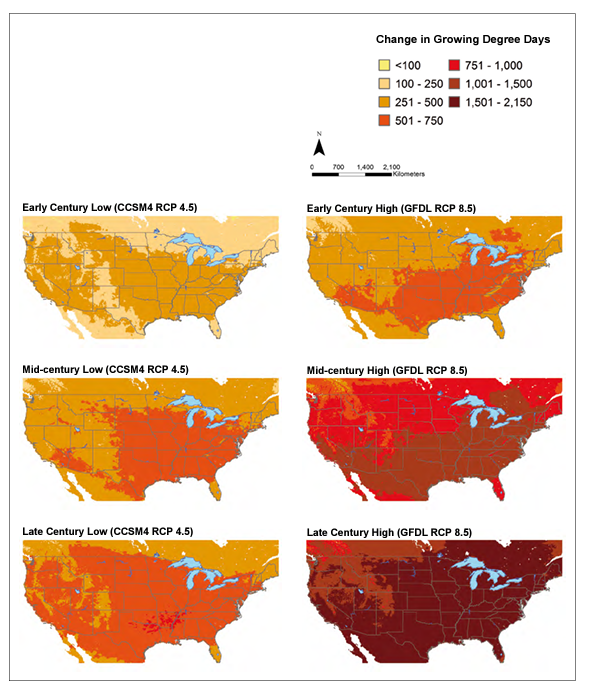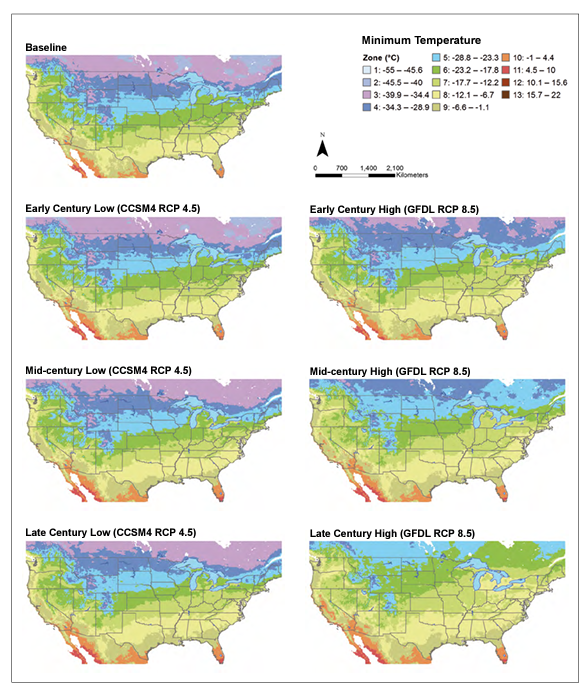We have all seen how climate change is clearly shaping our lives, and it is becoming increasingly evident in how planting schedules have shifted in both the agriculture industry and even your garden at home. As temperatures rise, weather patterns shift, and extreme and anomalous events become more frequent, farmers and gardeners alike are facing new challenges in determining the optimal times to sow their seeds. How will all of this actually impact you? And what are the implications?
Changing Climate and Changing Schedules
Historically, farmers and gardeners relied on established planting calendars based on local climate patterns. However, the unpredictability brought about by climate change, and other recurring and active climate modalities, has thrown these planting calendars into disarray making it increasingly difficult to predict the optimal times for planting crops.
The USDA has published a study that visualizes how climate change will continue and potentially intensify with time. They have even developed an interactive storymap to show what the potential intensification of climate change through this century will look like in the contiguous United States. For example, the image below depicts how evolving temperatures could cause a dramatic shift in growing degree days in the future.

Implications for Agriculture
The agriculture industry, which forms the backbone of global food production, is particularly vulnerable to climate-induced disruptions. The unpredictability of weather patterns can lead to decreased crop yields, impacting food availability and prices, which you have undoubtedly noticed at your local market in the form of higher food prices, scarcity of certain items and less than optimal produce.
The EPA has noted that, “Climate change can make conditions better or worse for growing crops in different regions. For example, changes in temperature, rainfall, and frost-free days are leading to longer growing seasons in almost every state. A longer growing season can have both positive and negative impacts for raising food. Some farmers may be able to plant longer-maturing crops or more crop cycles altogether, while others may need to provide more irrigation over a longer, hotter growing season.”
In response to these challenges, some farmers are adopting innovative techniques such as utilizing climate-resilient crop varieties and employing precision agriculture methods. These approaches can help mitigate the risks associated with changing weather.
Gardening’s Changing Landscape
Have you noticed that the plants in your yard seem to be coming up sooner or are more plentiful this year? I definitely have. Climate change isn’t just impacting large-scale agriculture; it’s also reshaping the world of home gardening. The average gardener that once relied on frost dates and local gardening advice are finding that the rules of the game have changed. As seasons become less predictable, home gardeners are investigating new planting strategies, such as succession planting and using protective structures like greenhouses or shade cloths, which can help extend the growing season and provide a buffer against unexpected weather events.
Nature.com recently studied the impact of climate and insect phenology. This study looked at how the timing of when moths and butterflies become active (phenology) is influenced by unusual weather conditions. Instead of just looking at the average climate, the researchers considered when there were particularly warm or cold days. They used data collected over 70 years in the Eastern USA and found that both warm and cold days had a strong impact on how long these insects were active and on flight duration. The study said that the effect on duration is likely driven by differential onset and termination dynamics. The researchers suggest that as unusual weather events become more common due to climate change, concluding that “understanding phenological responses under global change must account for unusual weather events, especially given they are predicted to increase in frequency and severity.”
Fine Gardening has a vested interest in this subject as well, citing that “Maintaining a high level of plant diversity will also provide a hedge against new insect pests that may turn up as their ranges expand. Gardeners can mix in experimental warmer zone plants while building a foundation of the tried-and-true. Annuals and herbaceous perennials make good candidates for experimentation since they can exploit longer growing seasons and warmer summers without being subjected to vagaries of a sudden February cold snap.”
The USDA also researched plant hardiness zones, which help not only those in the agriculture industry determine what plants to plant where, but home and professional gardeners as well. Due to their ability to depict the cold tolerance of numerous plant species, including woody varieties, hardiness zones serve as accurate indicators of plant range boundaries. As temperatures warm and zonal patterns shift in the future, these variations will prove valuable in outlining the niche limitations of multiple plant species and offer insights into their potential future ranges.

As our evolving climate continues to disrupt traditional planting calendars, the increasing unpredictability of weather patterns necessitates adaptive strategies and a reimagining of how we interact with our environment. While the impacts of climate change on planting schedules are undeniable, they also serve as a catalyst for innovation, encouraging farmers and gardeners to explore new methods and work collectively to ensure a sustainable and resilient future. Climate change will reshape planting and sourcing due to its future impacts on growth patterns. Hey, maybe I’ll even be able to plant a Crepe Myrtle in Michigan without killing it one day!
Weather Source has the necessary tools and expertise to help agriculture businesses in a multitude of ways, including crop modeling, properly collocated and hyper local weather information, identification of early starts to growing seasons, phenology and vegetation indices and a lot more. Since our data is hyper-local and actionable down to a precise farmers field, agricultural customers are able to harness mother nature and generate relevant and actionable insights to help maximize yield and mitigate risk associated with the changing weather.
Similar to its impact on various aspects of our lives, climate change is influencing our most critical resources, necessitating adaptation for long-term sustainability. Is your business prepared for the road ahead? Contact us to explore how we can assist you in navigating the challenges of weather and climate, both in the present and for what lies ahead.



